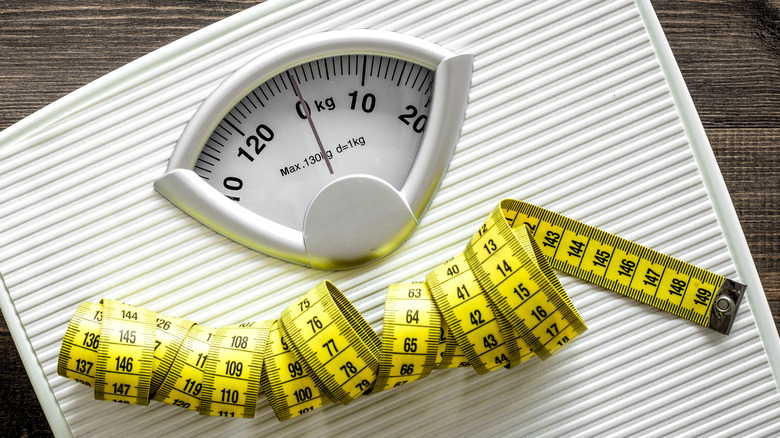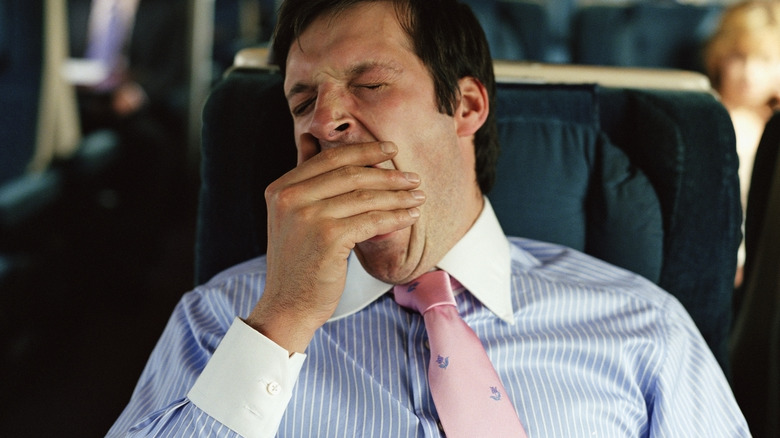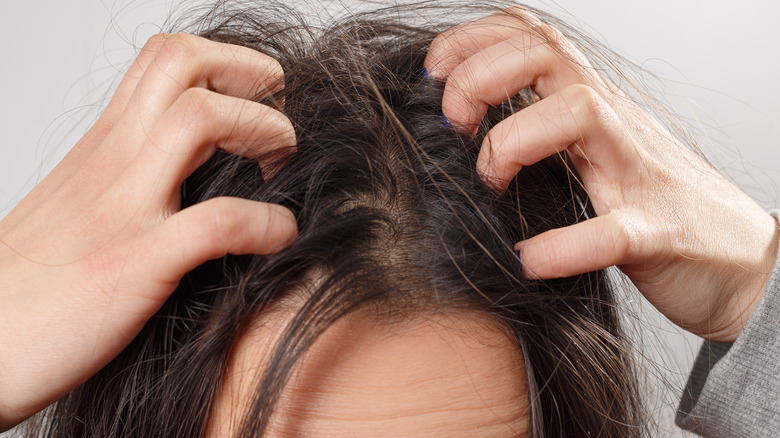What Happens To Your Body When You Suddenly Stop Eating Bread
The United States' view of bread and grains in general has changed over the years. In 1992, the U.S. had the Food Guide Pyramid, via Harvard Health Publishing. As the name indicates, it was shaped like a pyramid and divided into sections, the largest one being for grains, including breads (per Britannica). UAB Medicine Diabetes and Nutrition Education Clinic Supervisor Barbara Roberts notes that the original pyramid not only didn't advise about eating whole grains but also allowed for up to 11 servings of grains per day.
Eventually, the idea of a food pyramid was replaced with MyPlate, which resembles a plate divided into different sections for different food groups, as well as a cup for dairy. And while grain products are still part of MyPlate, the current MyPlate website explains that the number of servings of grains (including breads) one should have daily varies because of factors like age, height, and physical activity. Plus, the website has information about both refined grains and whole grains.
Besides the evolution of the Food Guide Pyramid into MyPlate impacting how we look at bread, low-carb dieting trends have also led some to cut bread entirely from their diets. How giving up bread might affect one's health, however, depends on things like the type of bread, the amount consumed, and an individual's health concerns. There can also be more than one cause behind a health change related to cutting out bread.
It could affect your blood pressure
When your heart pumps blood, the blood goes through your blood vessels with varying amounts of force (via the American Heart Association). When that force is regularly above what is considered normal, that is called hypertension, or high blood pressure. And as the University of California, Davis explains, hypertension and consuming foods that are high in sodium can go hand in hand. Since bread can be loaded with sodium (according to Harvard Health Publishing), this means that bread could increase the odds of developing high blood pressure.
In addition, a 2020 study in the journal Nutrients found a connection between eating bread and elevated blood pressure. This study involved adults ranging from 20 to 50 years old who lived in Mexico City and recommended reducing sodium in bread products in order to help the populace manage their elevated blood pressure better. However, the Mayo Clinic notes that foods that contain whole grains could help not only manage hypertension but also possibly lower the odds of having it at all.
If you still want to cut bread (including whole grain breads) from your diet, then try replacing it with a different whole grain option that doesn't have the same sodium content, per U.S. Department of Health and Human Services. For example, you might want to add quinoa to your lunch or brown rice to your dinner. Wild rice and barley are also good options.
It could impact your blood sugar
Exactly how bread affects blood sugar can vary. Registered dietitian Lisa Andrews explained to Eat This, Not That! that white bread can lead to blood sugar levels rising and falling quickly, but whole grain breads typically don't cause those types of spikes and crashes. This is due to these breads having different glycemic indexes.
As endocrinologist Dr. Alexander Williams tells the Cleveland Clinic, "The glycemic index is used to classify foods that contain carbohydrates, their potential for raising blood sugar and how quickly they raise your blood sugar." Foods are placed on a scale from zero to 100, and the higher up a food is on the scale, the higher its glycemic index and likelihood to cause blood sugar spikes and crashes. White bread, for example, has a glycemic index of over 70, making it a high glycemic index food. Per Andrews, whole grain bread has a lower glycemic index than white bread (via Eat This, Not That!).
Dr. Williams also points out (via the Cleveland Clinic) that there has been research supporting the idea that sticking to low glycemic index foods might be beneficial for both avoiding and reducing the risk of long-term complications of type 2 diabetes. If you have type 2 diabetes, Everyday Health advises against eating certain breads, such as those made with white flour and/or with high amounts of molasses, sugar, dextrose, or high fructose corn syrup.
It might help you lose weight
In a 2021 newsletter, action star and former California governor Arnold Schwarzenegger shared that giving up bread was helping him lose weight (via Insider). But while this seems to be a ringing endorsement for those with weight loss goals to cut bread, there's more to bread and weight management than that.
As dietitian Tai Ibitoye explained to Insider, bread has gotten a bad rap as a food that automatically equals weight gain. This has led to the misconception that a person must remove bread entirely from their diet in order to drop unwanted pounds. But according to former bodybuilder Nick Shaw, "It's not that bread makes you lose weight magically, but it's the reduction in calories and of good-tasting foods being a good way to eat a bit less that helps with weight loss." In other words, reducing calories is key to weight loss — calories that can technically come from any source.
It's worth noting that if you cut carbs (which you'll find in bread), that can result in losing water weight, per Medical News Today. Unsurprisingly, eating a balanced diet that is made up of a variety of foods that are properly portioned makes for a better approach to losing weight than, for example, cutting all the bread from your meal plan. Ibitoye also advises against cutting all the foods from a particular food group in an attempt to reach weight loss goals (per Insider).
It might affect your energy levels
Since bread contains carbs, and carbs provide energy, bread is a way to help fuel up your body with energy. Conversely, cutting bread from one's diet can result in a drop in that energy. However, there is a bit more to consider when it comes to bread and energy levels.
The type of bread you eat can impact how long or short your energy from the carbs in that bread lasts. As registered dietitian Christina Laboni told Eat This, Not That!, white bread might be a good pre-workout choice, partly because your body digests it faster, leading to a quick increase in energy. However, if you're in an office setting, white bread might leave you feeling tired, since the energy boost it gives wears off more quickly. But whole-grain bread, which is digested at a slower rate, gives you energy that lasts longer. In addition, dietitian Tai Ibitoye told Insider that cutting carbs can mean missing out on nutrition and result in lethargy.
If you still want to cut back on bread, you might want to add other sources of whole grains to your diet to keep your energy levels from crashing. The Harvard T.H. Chan School of Public Health suggests adding whole grains to a salad, as well as having oatmeal for breakfast. However, it's also advisable not to eat instant oatmeal; instead, choose an oatmeal high in whole grains and low in sugar.
You might notice changes in your bowel movements
According to MedicineNet, white bread not only lacks fiber but is also typically loaded with starch. Because of these factors, eating this type of bread could lead to or worsen constipation. But that doesn't mean all breads are necessarily bad for your bowel movements.
Whole-grain breads can have a beneficial impact on constipation. As their name indicates, whole grains are essentially the entire grain, as opposed to refined grains, where parts of the grain are removed (via the Mayo Clinic). One of those parts is the bran, which is the main source of a grain's dietary fiber content. Because whole grains don't lose their bran, they are rich in fiber, and thus might help keep one regular (per MedicineNet). In addition, a 2010 study in the Journal of Nutrition found that whole-grain rye bread could be more effective at alleviating constipation than both wheat bread and laxatives.
Although there's evidence that rye bread might help with constipation, MedicineNet states that rye, as well as wheat and barley, contains gluten, which can also sometimes cause constipation in certain individuals. For example, someone with celiac disease might experience constipation after eating bread that contains gluten. The bottom line is that cutting bread from your diet could either raise or lower your chances of constipation, depending on the type of bread you regularly eat and your health concerns.
Is there a connection between bread and depression?
According to Science Alert, a study in the American Journal of Clinical Nutrition involving more than 70,000 post-menopausal women concluded that the women were more or less likely to have depression depending on their diet. It found that as refined carbohydrate and sugar consumption went up, so did the odds that post-menopausal women would have depression.
Conversely, the women who ate whole grain foods (along with other foods rich in dietary fiber) saw their chances of eventually having depression go down. A plausible reason why this is the case is the glycemic index of certain foods. Foods with a lower glycemic index, like whole grains, don't cause blood sugar spikes and crashes like foods with a higher glycemic index (e.g., white bread). Blood sugar crashes can affect one's mood, which the researchers speculate could be a factor when it comes to depression.
Changes to one's diet might help not only lower the risk of developing depression but also help treat it. However, the Cleveland Clinic explains that although we believe factors like genetics might play a role, we're still figuring out exactly what causes depression. So, if you or someone you know has depression, speak with a medical professional before trying dietary changes to try to help treat it.
If you or someone you know is struggling or in crisis, help is available. Call or text 988 or chat 988lifeline.org
You might experience less gas and bloating
When a person has celiac disease, their immune system treats the protein gluten like a dangerous foreign invader (via the Mayo Clinic). Over time, this autoimmune disorder causes damage to the small intestine. Symptoms of celiac disease can include bloating and gas (per WebMD). However, it's possible that eating bread that contains gluten can still cause gas and bloating, even if one doesn't have celiac disease.
As the Cleveland Clinic explains, it's possible to be gluten intolerant, which isn't the same thing as celiac disease. Nevertheless, someone who is gluten-intolerant can experience gas and bloating for hours or even days after eating gluten. Additionally, they might also have constipation, diarrhea, nausea, vomiting, and abdominal pain. Brain fog, fatigue, anxiety, and depression are also potential signs of a gluten intolerance. Other red flags of this health problem include developing headaches, skin rashes, and anemia.
If you suspect that the gluten in bread and other foods is the culprit behind symptoms like gas and bloating, don't self-diagnose yourself and go on a gluten-free diet, via Cleveland Clinic. Since celiac disease causes damage, giving up gluten helps reverse that damage but can also mask celiac disease from a health care professional and lead to a misdiagnosis. If you are properly diagnosed with gluten intolerance and determine that the gas and bloating are because of it, then a gluten-free diet, as well as probiotics, might help.
You might feel less congested
According to the American College of Allergy, Asthma, & Immunology (ACAAI), only around 35% of children who have a wheat allergy don't grow out of it. In addition, wheat allergy symptoms are more likely to be mild than severe. But if you experience congestion every time you eat bread that contains wheat, you might have this allergy.
A person with a wheat allergy can experience a stuffy or runny nose. Sneezing and asthma are also possible red flags of a wheat allergy. Someone with this allergy might also have indigestion, experience stomach cramps, feel nauseous, and/or vomit. Skin issues like hives or a rash might also develop as a result of a wheat allergy. Additionally, headaches are also sometimes caused by an allergic reaction to wheat. And while typically a wheat allergy only brings on mild symptoms, it can also cause anaphylaxis, which can be deadly.
Since it's possible to confuse a wheat allergy with other health issues like celiac disease, the ACAAI recommends having a medical professional like an allergist diagnose someone experiencing potential symptoms of this allergy. And while avoiding foods that contain wheat (like some breads) is important for managing a wheat allergy, foods that technically don't have wheat can still be cross-contaminated with wheat (e.g., when a food manufacturer produces foods that contain and don't contain wheat in the same plant).
Skin problems might improve
If you have gluten sensitivity, you could experience a chronic condition called dermatitis herpetiformis (via the Cleveland Clinic). Potential signs include having skin problems like blisters and bumps that are itchy after eating foods with gluten (like bread). While dermatitis herpetiformis can occur on its own, a person can simultaneously have it and celiac disease, including asymptomatic celiac disease. So, having it professionally diagnosed could reveal two different medical conditions.
Dermatitis herpetiformis skin issues usually happen on specific areas of the body, like the hairline and scalp, the elbows, the buttocks, and the knees. Typically, the bumps that form because of dermatitis herpetiformis are in a cluster and can be anywhere from red to purple in color or simply a darker color than the patient's skin tone. In addition, the skin where the cluster occurs is usually discolored. Blisters are also possible and might appear like the kind caused by herpes. However, dermatitis herpetiformis is a different condition and not related to herpes.
Besides skin problems, dermatitis herpetiformis can also be the culprit behind oral health issues. For example, a person with this condition could notice horizonal grooves on their teeth. They also might experience pitting in their teeth's enamel, as well as their teeth becoming discolored. And while it's not common, canker sores can also be a sign of dermatitis herpetiformis.









